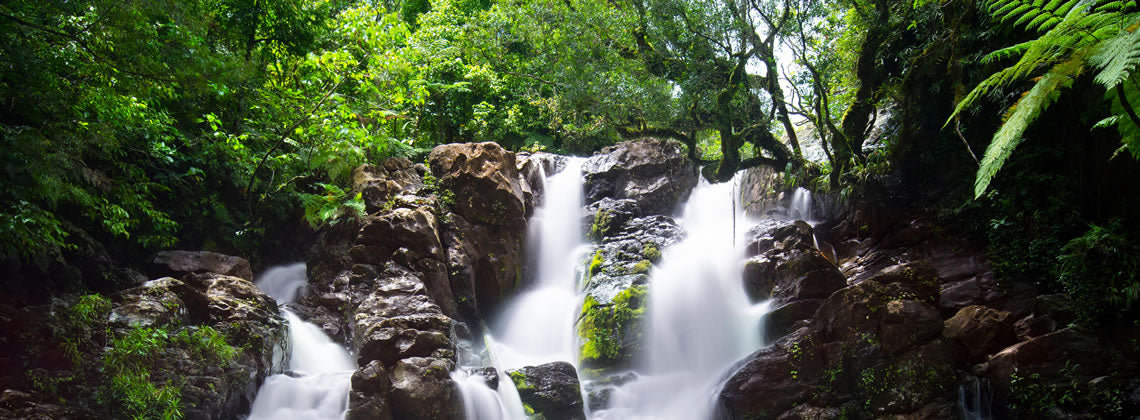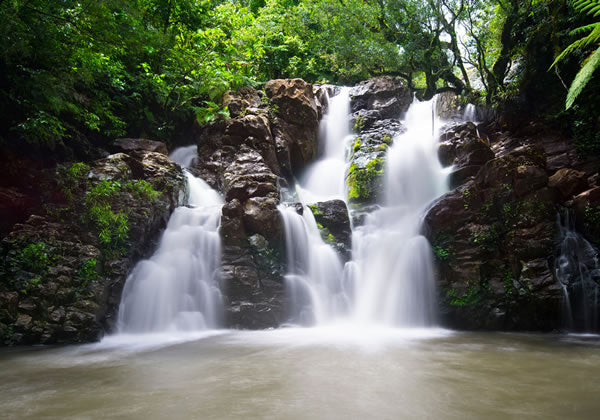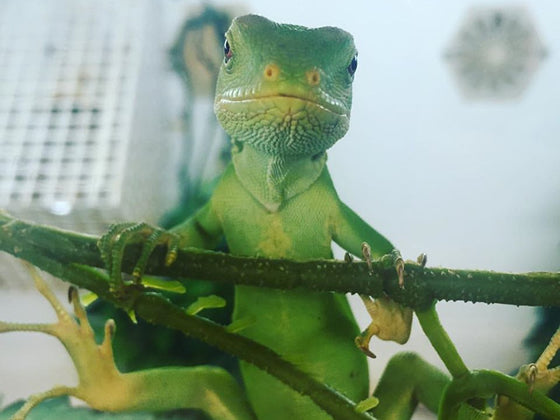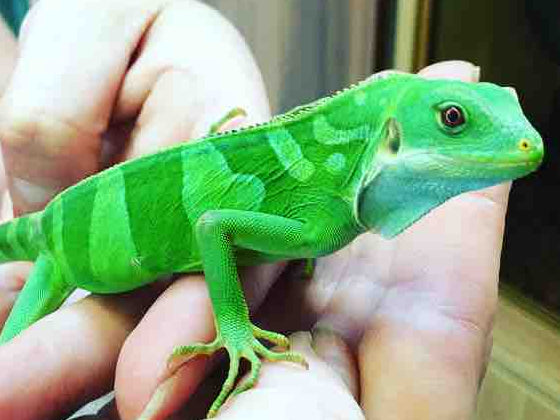Free Delivery
on order over £99*
Fiji iguanas are a very special lizard found on the Lau islands of Fiji. They are one of a very few species of Iguana found outside of the New World. It is valued as a national treasure within Fiji and is currently protected because the population is dwindling due to introduced predators and land destruction. The iguana is typically bright green with a very short strip of dorsal spines. A blue grey pattern runs the length of the lizard becoming bands in places towards the tail.


Fiji iguanas come from a very warm environment so they struggle with the cold of the UK. To insulate against this we recommend keeping the iguana in a wooden vivarium. Due to the temperature gradient required we would normally select an enclosure a minimum of 4 x 2 x 3ft (Width x Length x Height).Ideally the enclosure will include plenty of vents on both the front and back of the enclosure. All of this ventilation should ensure that heat is lost from one side of the enclosure to the other while keeping the basking spot itself at a consistent temperature.Fiji iguanas do not tend to be a shy species so we would use this size enclosure for the juveniles or adults. To make sure there is not too much open space for a juvenile we provide a lot more decorations to begin with and slowly remove them as the iguana grows.
Naturally, Fiji iguanas spend a long time basking in the full heat of the sun. As such they require a very warm basking area of 95of during the day. We try to provide this heat over 1/3 of the enclosure while letting the rest of the enclosure cool to 75of on the opposite side. To achieve this we attach a strong basking lamp to the ceiling of the enclosure on one side. This is surrounded by a guard and controlled by a high temperature dimming thermostat to make sure that the temperature is kept correct throughout the day. The basking lamp is left on for 10-12 hours per day.
At night, all of the lights should go off and the enclosure should be completely dark. This should make sure that the iguana has a clear day night cycle.
Though the thermostats we sell are very reliable it is always best practice to monitor your temperatures with a thermometer. A 5of variance on the basking spot is nothing to worry about as long as your cool side is still cool. A simple dial thermometer on each side should be sufficient but digital probe thermometers are much more accurate.


Fiji iguanas are a basking species by nature but they do get partial cover from the canopy and plants so they need an semi-intense UVB source. We recommend a 6-10% UV tube running at least 2/3 of the length of the enclosure. In some cases we may increase the strength of the lamp depending on how tall the enclosure is however, in a normal 3ft tall vivarium 10% should be suitable.
UV tubes are currently available in 2 sizes, T8 and T5. The T8 lamps are around 1 inch in diameter, they must be replaced every 6 months or so and they have an effective range of 9-12 inches. T5 lamps are the newer iteration. They are around half an inch in diameter, last 12 months and have an effective range of 18-24 inches.
For these taller enclosures we would always recommend a T5 unit. This unit should be mounted to the ceiling and close to the back wall. This configuration will provide a nice UV gradient from the back of the enclosure towards the front and top to bottom. With the UV and basking lamp set up this way we achieve a temperature gradient along the length and a UV gradient along the width of the enclosure. This means that whatever the iguana's requirements they can find the perfect position within the enclosure.
Though the iguana is a basking species it may desire some time in an area with less light or an area with no light. To achieve this we would provide partial and full hiding spots throughout the enclosure.
Fiji iguanas thrive in a mid to high humidity environment with absorbent decorations to climb over and bask on. When selecting a bedding we try to ensure that the pieces will absorb the moisture from the morning spray and release it throughout the day. In our store we normally use a coarse bark woodchip as it is clean, cheap, easy to spot clean and dust free. If you prefer a more natural looking decoration a soil mix would be perfect. If you plan to keep the iguana in a bio-active enclosure a nutrient rich soil mix with a drainage layer below it.
Though the iguana has a temperature gradient running from side to side which we will be keeping at the correct temperatures there are times when the iguana will want to get really hot. To allow this we use hard wood decorations like grapevine or lliana pieces situated near the warm end but far enough from the lamps that the iguana is not at risk of coming into contact with the basking lamp. A network or absorbent oak and troncho branches against grapevine or lliana pieces should be used to allow the iguana to get up and around it's enclosure.
As discussed in the lighting section there will be times when the iguana does not want any UV and needs a bit of shade. To ensure that the iguana can get away from the light whenever necessary we advise spreading full and partial cover throughout the enclosure. Examples of full cover decorations would be caves, flat cork pieces or any other ornament that provides a shady spot to rest. Examples of partial cover would include tall plants, trailing plants and themed ornaments.
Fiji iguanas are omnivorous meaning that they can eat a varied diet of vegetables and insects. In the wild the iguanas can eat vegetation but they normally only do this for hydration. The bulk of their diet would be small and easy to digest insects.
For this species we would recommend brown crickets. They are very nutritious, fairly easy for the iguana to hunt, widely available and great value for money. If your iguana will not take them, black crickets and locust are also a brilliant alternative. Every now and again you might want to provide your iguana a treat, for this purpose you could feed: waxworms, calciworms, cockroaches, mealworms or beetle grubs. The grubs and worms tend to be quite fatty so we normally offer these a maximum of once or twice a week. Mealworms, morio worms and cockroaches can be difficult to digest so we would normally only provide these to mature iguanas (12-18 months or older) and only once or twice a week.
The iguana will also consume a considerable amount of fresh vegetation. Good foods include dandelion, clover, honeysuckle, leafy salads, watercress, curly kale, brussel tops, spring greens, coriander, parsley, rocket, carrot, parsnip, courgette and bell peppers. The bulk of the vegetation should be leafy greens. We will replace this daily.
Every now and again the iguana can be fed fruit though we tend to avoid acidic fruits like citrus, apples and strawberries and would instead try banana, mango or blueberries.
Once in the morning and once in the afternoon we spray the enclosure with room temperature water. While spraying the enclosure we aim to saturate the absorbent decorations and leave the ornaments and leaves with a fine layer of water droplets. The iguana should drink from its ornaments after each spray.
We always include a small or medium sized water bowl in the iguanas enclosure. You might never see the iguana drink from it but it should be there as a back-up. You might notice the iguana use it for bathing, this is usually to cool down or to help loosen it's shedding skin. The water bowl should be kept on the cool end of the vivarium to make sure that the water doesn't evaporate too quickly.
Fiji iguanas will get most of what they need from their diet but there are some vitamins and minerals that they require in higher concentrations. These are normally provided in the form of calcium and vitamin powders which are dusted onto the live food.
There are many brands and types of supplement but normally they come down to a pure calcium, calcium and vitamin or vitamin only supplement. Within these groups they will also either include or exclude synthetic vitamin D3. Vitamin D3 is produced by the reptile when it is exposed to UVB and among other functions it allows the iguana to use the calcium in their diet. If you are sure that the UVB levels in your enclosure are perfect you can use a supplement without D3, if you are not sure it would be best to use a supplement with some D3.
In our store we currently use a simple calcium powder with D3 and a balanced multi-vitamin with D3 called nutrobal. For most of the animals we alternate these daily so that they get their vitamins every other day while getting calcium every day.
If you keep a male and female together, they may breed. You do not need to do anything to encourage this. As long as they are healthy and the conditions are good, it will happen naturally. You need to consider whether you want this to happen before introducing the pair. What will you do with the babies if you incubate the eggs?
A gravid female should have access to a nesting box to lay her eggs. The box should be large enough that she can fully turn-around inside it. Inside the nesting box we use a soil mix that is kept humid enough to hold its shape but not so wet that it will saturate any eggs. We have found that ProRep spider life is perfect for this.
Once laid, the eggs should be incubated in an incubator at 84oF. We incubate our eggs in sealed boxes on a moisture rich substrate (such as Hatchrite) to trap the humidity around the eggs. After approximately 160-170 days the eggs will start to hatch, the first babies to emerge will encourage the rest of the eggs to hatch.
Fiji iguanas, as with most pets, require a clean environment to thrive. We recommend a spot clean as often as possible (every day) and a full clean every 4 weeks or so. If you are keeping the iguana in a bio-active enclosure you can spot clean and monitor the enclosure. It may still be a good item to change out the bedding a few times per year.
When cleaning the enclosure you should remove your animal, all decorations and all of the bedding. Once the enclosure is clear you can spray it all over with a reptile friendly disinfectant. These usually work very quickly and only need to be left for around 30 seconds, instructions can normally be found on the disinfectants packaging. Once the disinfectant has done its work it can be wiped away from the surfaces with a paper towel. In some cases you might want to repeat this process a second time to ensure that the enclosure is thoroughly cleaned.
Your decorations can be cleaned in a similar method, simply spray them down with the disinfectant and rinse thoroughly with water before drying them off and putting them back into the enclosure. We recommend this process is done during the day time to make sure that the iguana will be going back to a warm vivarium for at least an hour before the basking lamps are turned off for the night.